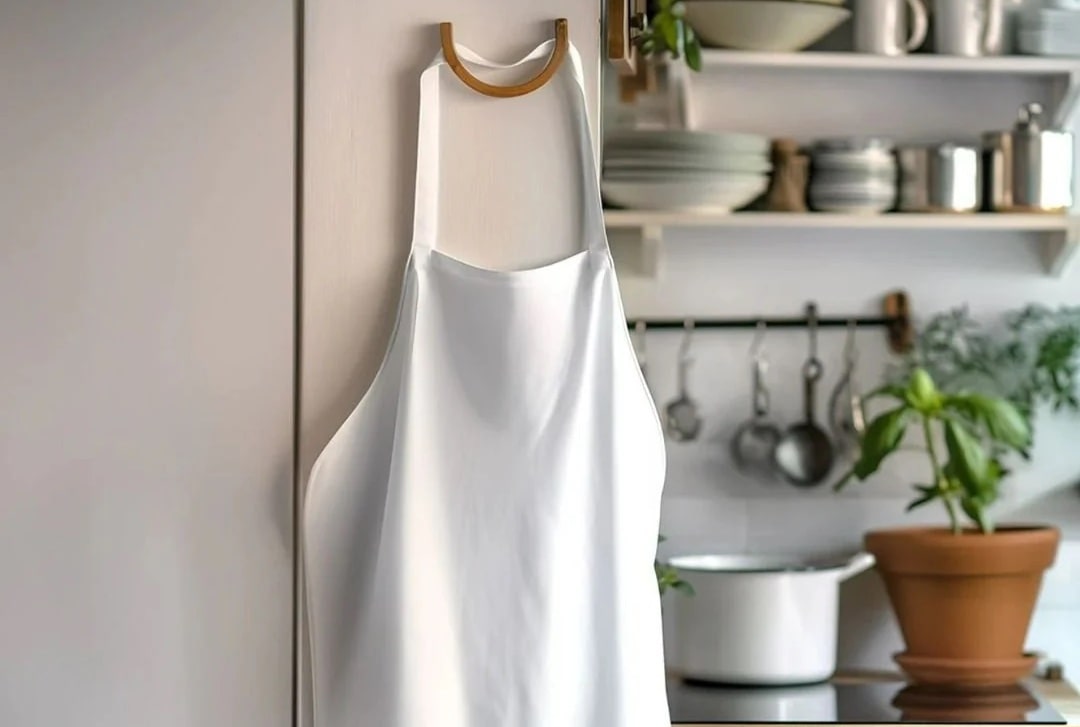The apron has been making a comeback in recent years. There was a period where it perhaps seemed a bit old-fashioned and, as some argue, a symbol of repression for women. With millennials getting used to microwave dinners, there was little need to be donning an apron. With wellness, agency, rituals and so on now a part of the lexicon associated with aprons, they are of course back in vogue.
A millennial's adult years are, however, too ephemeral a time span to really understand the heritage of the apron. From its practical beginnings in ancient civilisations to its modern resurgence in sustainable fashion, the apron has been on quite the journey. One that not only highlights the apron's versatility but also traverses a range of styles through the ages.
Origins of the Apron and Early Sustainability
The earliest depiction we have of aprons comes from Ancient Egypt. Egyptian men’s clothing was centred on a kilt called the schenti. Initially made from leather, the schenti evolved to be made from linen, a more suitable fabric for the scorching Egyptian climate. At some point, noblemen took to wearing a triangular apron that hung down in front of the apron. The apron resembled a pyramid with the pointy tip at the waist and the flat base close to the knees. This apron would also be starched in line with other clothing practices suggesting cotton/linen was the preferred fabric. The function of the apron here appears to be purely aesthetics rather than any specific utility.
Medieval Resourcefulness and Durable Materials
During the Middle Ages, aprons became essential for tradespeople—blacksmiths, cobblers, and masons—who required protection from their gritty work environments. Constructed from sturdy materials like leather and heavy canvas, these aprons were designed for durability, reducing the need for never ending replacements. By this stage, the apron had clearly evolved into a functional piece of clothing. If you’re struggling to visualise these kinds of aprons, you can get a sense of how they likely looked from the smiths that are visible in the fantasy TV show, Game of Thrones.
It was around this time that the word “apron” was born. The etymology of the word suggests that the Latin word “mappa” meaning napkin is the original source. By the medieval period, “mappa” had become “nape” meaning tablecloth and a “naperon” was a smaller cloth designed to protect the tablecloth from stains. A naperon became “a napron” and then “an apron” as it crossed over into English. All of the words here describe a protective cloth that shields another object (a shirt, a tablecloth or a table) from getting stained.
The Renaissance: Fashion Meets Function
The Renaissance era marks the period in Europe when there was a shift from the Middle Ages to modernity due to it being a precursor to Enlightenment values coming to the fore. Renaissance is the French translation of the Italian word rinascita meaning rebirth. It was a period of great change in various fields including the arts as people sought to revive the classical period’s achievements and surpass them.
With an injection of Renaissance flourish, even the everyday apron transitioned into a fashionable accessory with more decorative elements involved. Adornment included lace and embroidery while the core fabric of the apron would be finer in nature. Women of means would wear washable aprons (or overdresses) to keep expensive gowns clean.
While Vermeer’s Milkmaid is from the Baroque period that followed the Renaissance, we can perhaps get a sense of what appears to be a softer fabric for a blue-half-body apron worn by even a kitchen maid (rather than the lady of the house who would be wearing something more elaborate).
Industrial Revolution: The Rise of Mass Production
The next major step change in the history of the apron occurred during the Industrial Revolution, which marked a turning point with the mass production of textiles. With an increase in factories and sewing machines, options increased in terms of length, fabric choices, embellishments like ruffles etc.

A man wearing a leather apron that has a split in the middle, a characteristic of a farrier's apron. (Source: Flickr). ca 1860s - 1980s.
At the same time, dress codes that extended to aprons were decreed that made the delineation in status between an employer and an employee more apparent. As one can imagine, staff uniforms were strictly regulated.
20th Century: Reuse and Recycling
Throughout the 20th century, particularly during times of scarcity like the World Wars and the Great Depression, aprons were often made from recycled materials, such as flour sacks and old clothing. Allegedly, as flour companies learned that flour sacks were being upcycled in this way, they changed the designs of their sacks to adopt printed patterns, thus making the clothing more elegant.
Post-Second World War, there was very clearly a new pre-eminent world power in the United States of America. Rather than a European country setting trends, fashion and design cues in the West started to get sourced from the USA. This meant that domesticated 1950s life in the USA provided inspiration by putting a new spin on the apron. In this cultural context, even though women were increasingly in the workforce, the apron signalled a highly competent housewife. This was visible in magazines that aimed to sell products to the housewife demographic often featuring a woman wearing an apron.

Apron advertisement from the 1950s (Source: Wikimedia Commons)
21st century: Wellness, Rituals & Gender Stereotypes
As people got busier, convenience became more valuable. TV dinners became microwave meals meaning that dinner preparation became less onerous. The apron retreated somewhat and was not so visible.
As the nutritional value of these TV dinners came to be questioned, many opted to cook, aided by meal kits in some cases. With the focus on health and wellness, whole foods and nutritious meals have become more important. The increasing importance of daily rituals as part of one’s self-care routine has meant that cooking gives another way out of the TV and takeaways lifestyle.
In modern times, gender stereotypes have loosened such that misogyny and sexism, while not eradicated, get called out frequently. Aprons in domestic settings are not seen as for women only. This has perhaps been aided in part by a raft of celebrity male chefs, such as Gordon Ramsay, regularly appearing in their best white aprons.
Classic video of a 23-year old Gordon Ramsay apprenticing under Marco Pierre White.
— Trung Phan (@TrungTPhan) April 12, 2024
Humble. No cursing or yelling. Just paying his dues on the pasta machine.
They had a volatile relationship but Ramsay credits White.
“I stood alongside Marco for two years,” Ramsay said on… pic.twitter.com/T42tEUaWCW
Or, moving down a tier, the sought-after white aprons worn by everyday contestants on Masterchef, which started in the UK and is now a global phenomenon.
With life and art iterating on each other, we have now got to the stage of having fictional and real celebrity chefs appearing on major TV productions. In recent years, this too has had an impact on perceptions that people have of the apron. The most notable example is of the TV show, The Bear, featuring Jeremy Allen White as a young chef, Carmen Berzatto, who returns from the fine dining world to take charge of the family sandwich shop. “Carmy” is regularly featured onscreen wearing a blue apron over a simple white tee and therefore the apron is associated with the fine dining world, more humble surroundings, and all of the aspiration in between.
Contemporary aprons and sustainable fashion
Aprons have undergone a transformation in perception over recent millenia! Whether that’s to do with your social status, your gender or your job. But that’s about perceptions and not about function, which has largely remained the same: protect some clothing from stains and other damage. At the end of the day, aprons are for everyone!
The form, however, has changed with a great variety of aprons available these days. As with everyday clothes, people are paying more attention to how things are made and sustainable options are sought after.

Yet, for all of the talk of wellness and mindfulness, busy modern lifestyles in urban settings make it difficult for many to cook meals at home every day. Such a slow lifestyle is a different kind of quiet luxury. For the days where you can indulge by investing some time in the ritual of a much-loved family recipe, you’ll want to do it in style and create memories.
Sustainable materials can help imbue everyday objects with longevity, simplicity and style. Take a look at our 100% organic cotton unisex apron.







